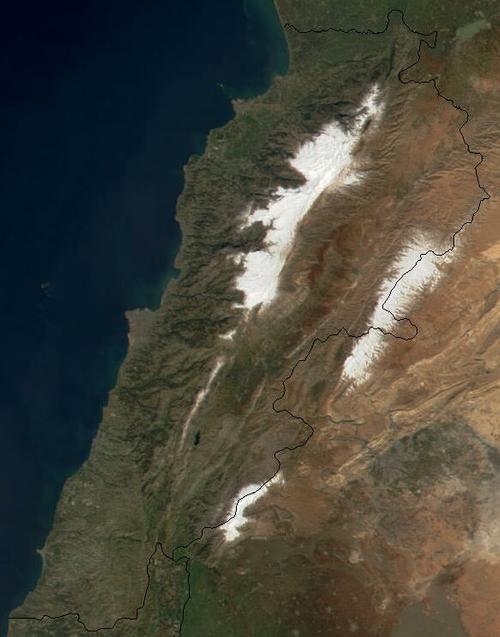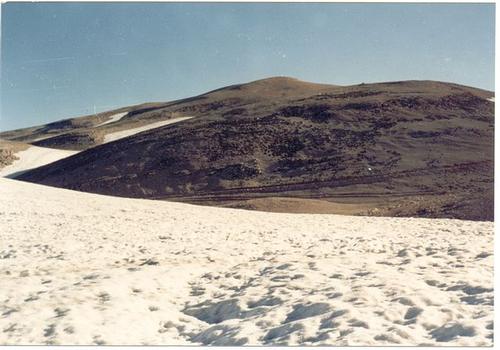LEBANON

Cities in LEBANON
| Beirut |
Geography and Landscape
Geography
Lebanon is located in the Middle East between Syria and Israel. The coast of Lebanon is on the Mediterranean Sea. The surface area of Lebanon is 10,400 square kilometres.

Landscape
The coastal plain is bordered by the steep Lebanon Mountains. The highest peaks are Mont Sannin (2630 metres) and Qurnat As Sawda (3080 metres). The Bekaa Valley, with an average altitude of 1,000 metres, is a plateau lying between the Lebanon and Anti-Lebanon Mountains.
 Qurnat As Sawda, Lebanon's highest peakPhoto: Erwin Franzen in the public domain
Qurnat As Sawda, Lebanon's highest peakPhoto: Erwin Franzen in the public domain
With its high mountains, the country has no shortage of water. The main rivers are the Litani and the Orontes (or Asi).
Climate and Weather
The climate in Lebanon is Mediterranean. This type of climate is characterised by mild wet winters and warm dry summers. In the winter, there is sometimes a lot of snow in the mountains. The best time to travel is from April to December. In the other months there is more rain.
Plants and Animals
Plants
Lebanon, with a surface area of 10,452 square kilometres, is one of the smallest countries in the world, but within its borders it has several completely different geographical areas. The 225-kilometre-long coastal strip, which stretches from Naqoura on the Israeli border to Nahr al-Kabir on the northern border with Syria, is very narrow. The main cities are located here, so this area is densely populated. There is a distinct Mediterranean climate with hot summers and cool rainy winters. Many fruits grow in the coastal areas, such as oranges, lemons, grapefruits, mandarins, dates, bananas and olives. Palm trees adorn the boulevards of the coastal towns. From the coast, the forested Lebanon Mountains rise to an impressive height of 3088 metres. Lebanon is the most forested country in the region.
Due to the large differences in altitude, the variation in soil composition and the relatively large amount of precipitation (rain and snow), there is an enormous diversity of flora. There is plenty of water everywhere, so fruit and vegetables are grown in the fertile mountainous regions, and they are of a great quality! Strawberries, cherries, apples and pears, apricots, peaches and plums, figs and grapes, but also almonds, walnuts and of course olives. In spring, the mountains and valleys are lush green and covered with purple cyclamen, native "Lebanon Violets", deep red anemones, orchids and irises. There are extensive forests with several species of pine tree, as well as cypress, conifer, juniper, beech and oak.
By far the most famous tree species in Lebanon is the Cedrus Libani, the Cedar of Lebanon. These trees once covered the entire Lebanon mountain range. The cedar is described in ancient writings such as the Epic of Gilgamesh and of course the Bible; King Solomon bought cedar wood from King Hiram of Tyre to build his temple. The cedar is the national symbol and adorns the flag of Lebanon. Unfortunately, there are not many of these magnificent giants left. It grows at high altitudes in the mountains, in protected reserves, especially near Bsharré, Tannourine and in the Chouf Mountains. The Chouf Cedar Reserve in Barouk, with its 550 square kilometres, is the largest nature reserve in the Middle East. Cedars over 2,000 years old and over 7 metres tall can be found here, as well as 16 other tree species.
The number of plant species observed and recorded here is already well over 500. Research and reporting are still ongoing. The Horsh Ehden Nature Reserve, near Tripoli in the northern Lebanon mountains, also has a unique flora, with 35 different tree species. There are some very rare tree and plant species here, such as the native Ehden milk vetch, Cicilian pine and wild apple.
East of the Lebanon Mountains, from north to south, stretches the Bekaa Valley, a very fertile and water-rich plateau at an altitude of 900 to 1100 metres. Intensive arable farming is practised here. In ancient times, this area was already known as the granary of the Roman Empire. Excellent wine has been cultivated here since ancient times. Tobacco, cotton, grain, potatoes and all kinds of fruit and vegetables are also grown here. In the northern Bekaa, hashish is still grown here and there (illegally but very profitably!), despite the government's attempts to force farmers to switch to other crops.
The second mountain range, the Anti-Lebanon, is located east of the Bekaa Valley and forms the border between Lebanon and Syria. This area has little precipitation and is therefore dry and relatively undeveloped. This is a sparsely populated area. The southern part of Anti-Lebanon, on the other hand, is a water-rich area. There are many villages here and a good quality tobacco is cultivated, as well as olives, figs, etc. This area lies at the foot of Mount Hermon, called Jabal al-Sheikh in Arabic, because of the white (snow) cap that this mountain "wears" most of the year. This creates numerous streams, waterfalls and streams that swell to rivers.
Animals
Lebanon has a special geographical location at a point where three continents cross. This is where enormous numbers of migratory birds pass through during spring and autumn. Thanks to the rising air currents over this area, these birds are able to cover enormous distances at a fast rate. Among the many bird species that have been observed, there are many birds of prey, such as the steppe eagle, black kite, Balkan sparrowhawk, steeplechief, golden eagle and screech eagle. Also the stork and the black stork migrate in enormous flocks over Lebanon twice a year.
In the national parks such as the Chouf Cedar Reserve, Tannourine Nature Reserve and the Horsh Ehden Nature Reserve, more than 200 species of birds have been observed, such as the spotted and golden eagle, black vulture, white pelican, several species of hawk, vulture, buzzard, falcon, but also the cuckoo, several species of owl, pigeon, woodpecker etc..
As many as 32 species of wild mammals have been observed, including gazelle, wolf, wild boar, lynx, jackal, hyena, red fox, weasel, badger, porcupine, hedgehog, hare, marten, etc. . There are 6 different species of bats, 4 of which are considered endangered.
In Lebanon there are several species of lizards, as well as the gecko, chameleon, many frogs and toads, about ten species of snakes and the Greek turtle.
About 6 km off the coast of Tripoli is an island reserve with a total area of about 6 square kilometres. The reserve can be reached by boat from Tripoli's boulevard. The islands are flat; the highest point is 6 metres above sea level. The soil consists of rock and sand and about 70 plant species grow here. It is a breeding ground for 10 species of migratory birds, a wintering ground for 24 species of birds and about 14 species of migratory birds come here to rest in spring and autumn. Some of the birds that have been observed here are: dunlin, common tern, sandpiper, stilts, marsh hawk, snowy plover and several gull species.
The reserve is also a breeding ground for several turtle species, including the green sea turtle, loggerhead sea turtle and leatherback sea turtle. It is also a breeding ground for the Mediterranean seal (Monachus Monachus).
The islands are home to lizards and some native snake species, as well as bats. There are plans to build a botanical garden in this reserve.
Sources
BBC - Country Profiles
CIA - World Factbook
Elmar Landeninformatie
Grünfeld, R. / Syrië, Jordanië en Libanon
Kosmos-Z&K
Jenkins S. & Jousiffe A. / Lebanon
Lonely Planet
Copyright: Team The World of Info